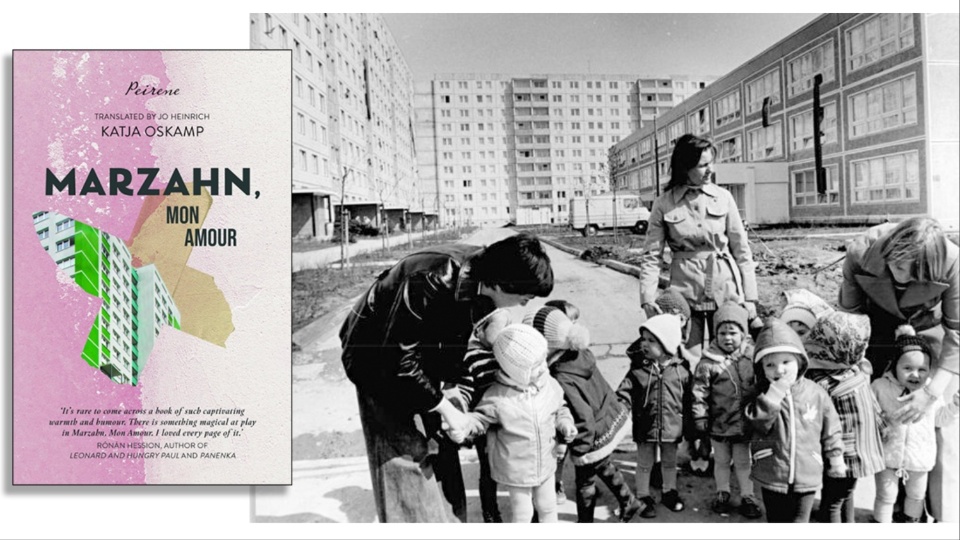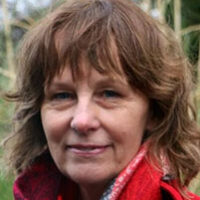
The winner has been announced for the annual International Dublin Literary Award for 2023, and the top prize goes to Marzahn, Mon Amour, by East German writer Katja Oskamp. The title stands out for East Berliners in particular, who immediately recognize Marzahn as the GDR’s once most ambitious and largest social housing program, providing homes for over 270,000 people.
The award was presented by the Lord Mayor of Dublin, Caroline Conroy, on May 25 as part of the city’s International Literature Festival.
The International Dublin Literary Award is an unusually democratic, grassroots prize, as nominations for it are submitted by over 400 public libraries in 177 countries. A worldwide changing panel of judges draws up a shortlist and selects the winning novel. Libraries anywhere can apply to take part in the nominations.
Participating libraries come from around the world, including Africa and Asia. They submit their nominations, based on their readers’ reception of books, to Dublin City Public Libraries. The award is designated for a book either written in English or one that has been translated into English. In the latter case, one-quarter of the 100,000 euro prize money goes to the translator, the remaining 75,000 to the author.
Marzahn, Mon Amour was nominated by Stadtbüchereien Düsseldorf, Germany. It is the kind of book that surprisingly made it past the establishment publishers who generally discourage voices from ordinary people about ordinary lives, and especially if they write about not so cool places.
In addition, Oskamp’s book is about ordinary East Berliners, most of them pensioners, most of them women, aging. In all these respects, Oskamp’s book had the cards stacked against it. And yet, not only was it published, and nominated for the Dublin Literary Award by a West German library, it incredibly won.
The book is firmly rooted in a GDR literary tradition—that of truly valuing the ordinary, everyday lives of people, inseparably linked to the world of work. Perhaps the most famous example in GDR literature is Maxi Wander’s Guten Morgen du Schöne (1977, Good Morning, Beautiful). It presents interviews with 19 women aged between 16 and 92, talking about their lives. A similarly themed book of interviews with men by Christine Müller, Männer-Protokolle (1985), was later followed by Christa Wolf’s diary-style publication, Ein Tag im Jahr (2003, One Day a Year), where she records her own reflections on the same date every year—Sept. 27—from 1960 to 2000.
The same interest in the everyday lives of ordinary people is reflected in the documentary by GDR filmmakers Winfried and Barbara Junge, whose epic series Die Kinder von Golzow (The Children of Golzow) began in 1961 and continued until 2007. It follows the lives of 18 people born between 1953 and 1955. This grassroots emphasis was directly linked to the GDR’s state cultural policy of making the arts directly relevant to the vast majority of the working population and encouraging them to participate in the arts.
The preservation of memory, as a fightback to the complete rewriting of history that took place after the annexation of the GDR by West Germany, became more important than ever. In contrast to some novels that bowed to the diktat of this New Order post-1990, the documentary style recording of ordinary people’s ordinary lives has claimed its own space.
A splendid example of this is Katrin Rohnstock’s interview-based book Mein letzter Arbeitstag: Abgewickelt nach 89/90. Ostdeutsche Lebensläufe (2014, My Last Day at Work: Wound up After 89/90. East German Life Stories). This book presents the memories of GDR working people and their lives. A younger generation is currently scrutinizing the actual life experience in the GDR, into which they were born, where childhood memories dominate, but they are old enough to rely on the truth of their memories and at the same time to reflect on post-unification life.
Among these authors are Andreas Ulrich, Die Kinder von der Fischerinsel (2021, The Kids from the Fischerinsel), and Grit Lemke, Kinder von Hoy (2021, Kids of Hoy). Lemke’s book captures beautifully the atmosphere of growing up in the new town of Hoyerswerda, built to house the workers in the lignite industry, the sense of community, their deep understanding of culture, and follows these young people’s lives as they free fall into the New Germany.
Katja Oskamp’s novel Marzahn, mon Amour opens with the author reflecting on her own story:
“The middle years, when you’re neither young nor old, are fuzzy years. You can no longer see the shore you started from, but you can’t yet get a clear enough view of the shore you’re heading for. You spend these years thrashing about in the middle of a big lake, out of breath, flagging from the tedium of swimming. You pause, at a loss, and turn around in circles, again and again. Fear sets in, the fear of sinking halfway, without a sound, without a cause.
“I was 44 years old when I reached the middle of the big lake. My life had grown stale: My offspring had flown the nest, my other half was ill, and my writing, which had kept me busy until then, was more than a little iffy. I was carrying something bitter within me, completing the invisibility that befalls women over 40. I didn’t want to be seen, but nor did I want to see. I’d had it with people, the looks on their faces and their well-meant advice. I sank to the bottom.”
This is a book about aging, among other things, the search to give meaning to life at every stage, and some new beginnings. Aged 44, the author-narrator retrains as a chiropodist. She finds a job in a friend’s salon in Marzahn. This book is about her customers and her colleagues. Due to the area’s demographics, and the chiropodist service, most (but not all) of her customers are elderly. Work is an important theme in the book, not only the narrator’s own working life, but also the past jobs of her clients: “I look after the feet of some former bricklayers, butchers, and nurses. There’s also a woman who worked in electronics, one who bred cattle, and another who was a petrol pump attendant.”
The reader encounters these people and their stories. Oskamp also tells of her non-hierarchical relationships at work, both with her colleague and the salon owner, and their day out together. The salon owner, too, shared the naïve expectation of an East German that her earlier hard work in a supermarket chain would be valued:
When, haggard from work and two slipped discs later, Tiffy handed in her notice and asked for compensation, her naïve request was turned down with derision. Maybe her conviction that life is a losing game stems from that time. (…) Tiffy’s new, even mightier, enemy is the tax office, demanding extortionate amounts every quarter. She hangs in there, grits her teeth, and lives so frugally that it pains Flocke and me sometimes.
To some, these stories may not seem very spectacular; others will recognize in them the reflection of the minutiae of everyday existence, including tragedy, the stuff of life. This becomes all the more authentic, as she relates some conversations in the Berlin dialect. The use of the Berlin dialect is in itself a hallmark of East Berlin, where it is still more widespread and used more generally across the social strata. This is something frequently observed by East Germans who have found that to speak the way the ordinary people speak is frowned upon the higher up the social ladder one ascends in the New Germany. And yet many persist—a small gesture of protest.
Oskamp writes with understanding and compassion, preserving and enacting the sense of solidarity and community that was a feature of GDR society. The characters in the book all support each other through life and through the difficulties of growing older and old. Their recognition of commonality supersedes any sense of superiority of status or money. Partly memoir and partly collective history, each person’s story, beginning with their feet, is individual and related with respect, frequently communicating the client’s sense of humor. Taken as a whole, the individual portraits depict a community of equals. Herein lies a specifically East German collective memory.
So perhaps it should not be so surprising at all that a German public library, catering as such libraries frequently do, to the not-so-well-to-do readers, chose Marzahn Mon Amour as their nomination for the International Dublin Literary Award. And once you’ve read the book, you won’t be surprised that it won the prize.
We hope you appreciated this article. At People’s World, we believe news and information should be free and accessible to all, but we need your help. Our journalism is free of corporate influence and paywalls because we are totally reader-supported. Only you, our readers and supporters, make this possible. If you enjoy reading People’s World and the stories we bring you, please support our work by donating or becoming a monthly sustainer today. Thank you!












Comments